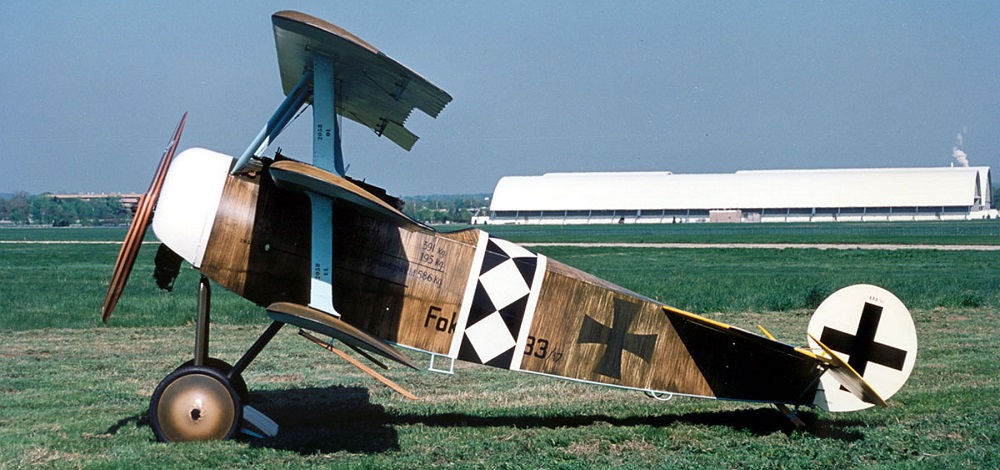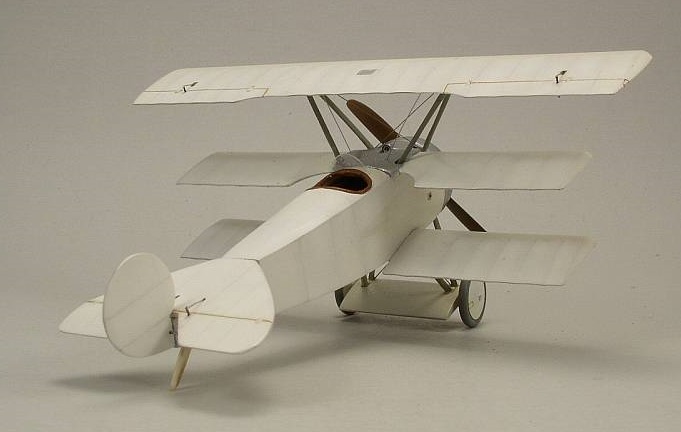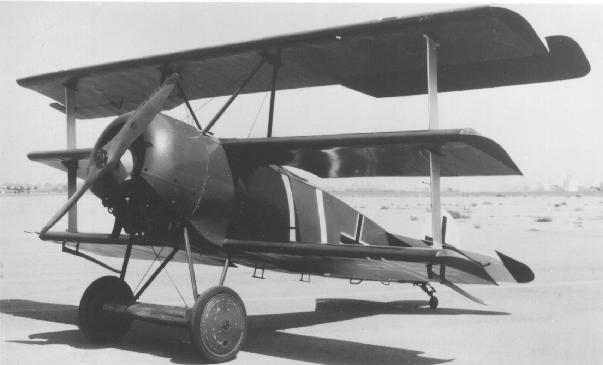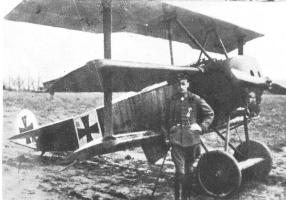
|
 |
Fokker Dr.I Triplane |
 |
 |
 |
 |
 |
|---|---|---|---|---|---|---|---|
 |
 |
 |
 |
 |
|||
 |
||
|
After the debut of the Royal Navy Air Service (RNAS) Sopwith Triplane in April 1917, many German and Austro-Hungarian firms accelerated efforts to design their own triplane fighters. The Albatros Dr.I was simply an adaptation of an existing fighting scout, while others contemplated more originality to their ideas. One such designer was Reinhold Platz who developed most of the new projects for Anthony Fokker following the death of designer Martin Kreutzer in a plane crash in 1916.1

The design of Platz resulted in the Fokker Dr.I which had an excellent rate of climb and could match the Camel for maneuverability. These merits outweighed its lack of speed at combat altitude. For two months the pilots of Jagdgeschwader Nr. 1, the Richthofen 'Circus', ably demonstrated its capabilities. Without doubt the most celebrated World War I ace was the legendary "Red Baron", Manfred, von Richthofen, whose "red triplane" has probably been the subject of more models than any other. However, some people doubt whether von Richthofen ever flew a completely scarlet Dr.I.2 Although not as fast as contemporary scouts, it was the agility of the Dr.1 that appealed to the leader of Geschwader 1. Once having flown it, he used it almost exclusively until he was killed on April 21, 1918. He achieved 19 of his last 80 victories in the triplane. Another dashing ace who flew the Dr.1 was Werner Ross of Jasta 10, whose skill and daring resulted in a final score of forty-eight Allied aircraft. He was an instinctive fighter in contrast with the calculated approach of Richthofen. In his last dogfight, he managed to damage nearly all his opponents from 56 Squadron. Surrounded by eight British aces, he fell to his death September 23, 1917 just hours after his 48th victory. The initial design was the Fokker V.3, a cantilever triplane with unbalanced ailerons and elevators. The wings were of great strength, with deep-section hollow box-spars, which were considerably light in weight. The wing plane spars were joined together to form a solid full-span spar. There were no interplane struts, and on tests there was a disconcerting wing vibration in flight. Therefore, the second Fokker triplane, the V.4, was given thin wooden interplane struts to eliminate the vibration. The cabane struts were steel-tube inverted vees. The V.4 became the prototype Dr.I (there is still doubt as to whether the V prefix meant Versuchsmaschine - experimental airplane, or Verspannungslos - unbraced wing).
 On the V.3 triplane, no interplane struts were installed. The semicircular tail-plane is visable and there is no overhang on the ailerons. |
||
|
The ribs were of plywood and were extensively fretted with lightening holes. The leading-edges as far back as the spar were covered with thin plywood sheet, tacked to the spar. The remainder of the wing was fabric-covered. The trailing-edges were of wire, which formed a scalloped profile when the fabric covering was doped.
Modifications to the V.4 were made to improve maneuverability. Overhang portions added to balance the ailerons,were fitted to the top wing only. The ailerons were framed in steel tube and fabric covered. The shape of their inboard ends varied. The middle wing had two cut-outs to improve downward visibility. The bottom wings on later models had small ash skids on the tips. |
|
The fuselage and empennage followed earlier successful Fokker designs. The welded steel-tubing fuselage was braced by diagonal wires to make a rigid box girder structure. The fuselage was fabric-covered including triangular plywood fillets from the cowling to just behind the cockpit, and plywood top decking.
 The mid-wing cutout improved downward visibilty. Shown here is a replica Dr.I with a tailwheel installed in place of the tailskid. The tailplane was also simplified by changing the shape from near semicircular to a triangular profile. The tail-plane, balanced elevators and balanced rudder were framed in steel tubing. Two struts braced the tail-plane from below. The center-section and undercarriage were of steel streamlined tubing. The axle had a large fairing, which provided extra lift. The wheels were sprung with elastic shock cord. A steel shod ash tailskid was fixed to the rear post. Production models used the 110 hp Oberursel rotary engine. The Oberursel was a straight copy of the Le Rhône. However, Le Rhône was preferred over the Oberursel due to the superior materials used over the home product. The 145 hp Oberursel UR III, 160 hp Goebel III and 160 hp Siemens-Halske III rotaries were experimentally fitted. The standard cowling was frontally enclosed to a point just below the propeller boss and provided with two cooling holes, but a few machines had 'horseshoe' cowlings. Twin Spandau guns which could be fired independently or simultaneously, were synchronized to fire through the propeller arc. The first three production aircraft were designated Fok. F-I 101-103/17. F-I 103/17 was supplied to Werner Voss on August 28th, 1917, and F-I 102/17 was flown by Manfred von Richthofen Sept. 1st, 1917. Richthofen also flew 114/17, (crashed Oct. 30th 1917), 127/17, 141/17, 152/17, 477/17, and 425/17. The Fokker triplanes were given the military designation 'Dr.I'. In late October 1917 Lieutenants Gontermann and Pastor were killed when their Dr.Is broke in the air, and the Dr.I was withdrawn from operations. The triplane was issued with modified wings in December 1917. The failures continued but, to a lesser extent. The Dr.I never recovered from this setback and was not supplied to many Jagdstaffeln. The cause of the wing failures was said to be from poor quality control rather than deficiencies in design. However, the failures always occurred in the upper wing of the aircraft. In the two most notable accidents of Gontermann and Pastor, the stripping of the top wing was almost total. During NACA investigation conducted in 1929 it was found that the upper wing of biplanes carried a higher wing loading than the lower wing. At high speed level flight, the upper wing could carry as much as 2.55 times more load than the lower wing. The increased wing loading, and poor workmanship could explain the failure of the upper wings of the Dr.1. Some 320 Dr.Is were built before production finished in May 1918.
 Leutnant Gontermann with Dr.I 1115/17, which broke up in flight on October 30th, 1917, and resulted in his death from the injuries sustained. It was in a Fokker Dr.I that Manfred, Freiherr von Richthofen was killed on April 21st, 1918. The controversy of his death on his last flight and fight, has never been resolved. It is not known if he was killed by an anti-aircraft gunner on the ground or by Canadian flyer Arthur "Roy" Brown. This has not been due to lack of witnesses, but of conflicting evidence given by witnesses on the ground and in the air. It has been reported that after WW I, Richthofen's airplane became part of Germany's aeronautical collection. This aircraft and others from the collection were evacuated before the serious air raids on Berlin took place in 1944. The aircraft were sent to Pomerania and other "safe" locations, now part of Poland. One inhabitant recalled as a small child seeing a red fuselage and wings in a dance hall. During a severe cold spell, he remembered sawing up the wings for firewood. According to Prof. Steinle of the Deutsches Technik Museum Berlin, there is every reason to believe that this is how Richthofen's Dr.I 425/17 airplane met an ignominious end. |
| Specifications: | |
|---|---|
| Fokker Dr.I Triplane | |
| Dimensions: | |
| Top Wing span: | 23 ft 7 3/8 in (7.19 m) |
| Mid Wing Span: | 20 ft 5 in (6.22 m) |
| Bottom Wing Span: | 18 ft 6 in (5.63 m) |
| Top Chord: | 3 ft 10 in (1.16 m) |
| Bottom Chord: | 3 ft 2 1/2 in (.97 m) |
| Gap Between Wings: | 2 ft 11 in (.89 m) |
| Wing Area (includes Axle): |
201.5 sq ft (18.66 sq m) |
| Length: | 18 ft 11 1/8 in (5.77 m) |
| Height: | 9 ft 8 1/8 in (2.95 m) |
| Weights: | |
| Empty: | 893 lbs (405 kgs) |
| Gross: | 1,289 lbs (584 kgs) |
| Performance: | |
| Maximum Speed: | 115 mph (185 km/h) @ sea level. |
| Service Ceiling: | 19,600 ft (5,974 m) |
| Fuel Capacity: | 16 1/2 gal (62.45 lt) |
| Powerplant: | |
|
One Oberursel 110 hp (82 kw) 9-cylinder rotary, aircooled or Thulin built 110 hp (82 kw) Le Rhône 9-cylinder rotary, aircooled. | |
| Armament: | |
|
Twin Spandau synchronized guns which could be fired independently or simultaneously through the propeller arc. | |
| Endnotes: |
|---|
|
1. A.R. Weyl. Fokker: The Creative Years. New York: Funk & Wagnalls, 1965. 58. 2. Peter Gray & Owen Thetford. German Aircraft of the First World War. New York: Doubleday & Company, Inc., 1970. 99. |
©Larry Dwyer. The Aviation History On-Line Museum.
All rights reserved.
Created November 28, 2001. Updated February 10, 2020.